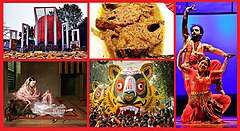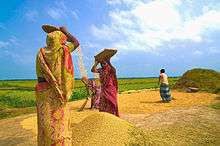Nabanna
Nobanno (Bengali: নবান্ন, Nobānno; lit: New Rice/Harvest) is a Bengali harvest celebration usually celebrated with food and dance and music in Bangladesh and in the Indian states of West Bengal, Tripura and Assam's Barak Valley. It is a festival of food; many local preparations of Bengali cuisine like pithe are cooked.
| Part of a series on |
| Bengalis |
|---|
 |
|
Bengali homeland |
|
Bengali culture
|
|
Bengali symbols |

Celebration
The festival is celebrated with mela which are called Nabanna Mela. It is one of the numerous festivals that gave the name "baro mase tero parban" (thirteen festivals in twelve months ) to the land of Bengal. Although the nabanna parban is somewhat different from other ones since it is not connected to a religion such as Ratha Yatra. The villagers and locals from both the major religious groups join the festival with equal participation. There are also several fertility rituals which make the festival truly a harvest ritual. The festival gets a lot of support from the creative army of Bengali culture. Several poets, musicians, baul and painters flock to such mass gatherings. There is a famous play written on nabanna by Bijon Bhattacharya which depicts the sad incident of the great Bengal Famine of 1943.[1] Nowadays the Festival "Nabanna" is celebrating every Bengali year (1st day of Agrahayan) in Dhaka, organised by Jatiya Nabanna Utshab Udjapan Parshad (National Harvest Festival committee) since 1998. Mr. Shahriar Salam is the Founder and main planner of the organisation. There are huge number of cultural activists, organisations & performing in a day long festival.
People from several villages of Howrah and even from other districts of West Bengal come here. People not only come to visit the Mela. In addition, they participate in many cultural programmes and competitions like 'Pithe Making' (Preparation of different sorts of Bengali Cakes), Seat-and Draw, Senior Citizens' Walking Competition, etc. An "Art-Camp" may attract creative minded people where artists from different states will participate. Some rare items of rural Bengal as "Dhenki" (Old-style Domestic Rice Mill), paddy of different varieties directly from the farmers' house are to be exhibited in the Exhibition ground. You can taste some delicious Bengali dishes like Pati-Sapta, Payesh (the latest addition is 'Vegetable Payesh'), Jilipipi (not Jilipi), etc. during the festival. Bengal's time-honoured culture and heritage will be presented to you in forms of Baul song, Chhou-dance, Jatra, Tarja, Kobi-gaan, etc. These artists come from different parts of the state to perform their talent and expertise in front of thousands of appreciative gatherings. Moreover, you can refurbish your collection of folk arts from the 'exhibition-cum-sale' stalls of handicrafts made by rural artisans.[2]
Social and cultural effects
Several dance and music forms have grown out of the ritual accompanied with the festival. Examples are Chhau, Bihu etc. Also the name nabanna is associated to several rural welfare projects and banks.[3][4] It has also been associated with the Indian People's Theatre Association (IPTA) movement of Bengali theatre.
The path-breaking production Nabanna of the IPTA in the 1940s, has been a motivating force in the left-tilted political approach of the next few decades on the stage[5] where luminaries like Utpal Dutt will glow with brilliance.
References
- O'Donnell, Erin (2004). "'Woman' and 'homeland' in Ritwik Ghatak's films: Constructing post-Independence Bengali cultural identity". Jump Cut. 47.
- "Nabanna Mela". Tapan Kar. Archived from the original on 30 April 2005.
- "Home – Information Technology & Communications Department – Government of AP". Apit.gov.in. Retrieved 22 August 2012.
- ICT R&D Grants Programme for Asia Pacific — Asia-Pacific Development Information Programme
- The theatre and class contradictions Archived 21 October 2007 at the Wayback Machine
Further reading
- Jahangiri, Mahmood Nasir (2012). "Navanna". In Islam, Sirajul; Jamal, Ahmed A. (eds.). Banglapedia: National Encyclopedia of Bangladesh (Second ed.). Asiatic Society of Bangladesh.
- Acharya, Namrata (29 September 2013). "Paddy production likely to be higher this year in WB in spite of floods". Business Standard. New Delhi. Retrieved 13 November 2014. – outlines rice growing seasons
